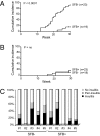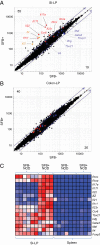Naturally transmitted segmented filamentous bacteria segregate with diabetes protection in nonobese diabetic mice
- PMID: 21709219
- PMCID: PMC3136249
- DOI: 10.1073/pnas.1108924108
Naturally transmitted segmented filamentous bacteria segregate with diabetes protection in nonobese diabetic mice
Abstract
Vertebrates typically harbor a rich gastrointestinal microbiota, which has coevolved with the host over millennia and is essential for several host physiological functions, in particular maturation of the immune system. Recent studies have highlighted the importance of a single bacterial species, segmented filamentous bacteria (SFB), in inducing a robust T-helper cell type 17 (Th17) population in the small-intestinal lamina propria (SI-LP) of the mouse gut. Consequently, SFB can promote IL-17-dependent immune and autoimmune responses, gut-associated as well as systemic, including inflammatory arthritis and experimental autoimmune encephalomyelitis. Here, we exploit the incomplete penetrance of SFB colonization of NOD mice in our animal facility to explore its impact on the incidence and course of type 1 diabetes in this prototypical, spontaneous model. There was a strong cosegregation of SFB positivity and diabetes protection in females, but not in males, which remained relatively disease-free regardless of the SFB status. In contrast, insulitis did not depend on SFB colonization. SFB-positive, but not SFB-negative, females had a substantial population of Th17 cells in the SI-LP, which was the only significant, repeatable difference in the examined T-cell compartments of the gut, pancreas, or systemic lymphoid tissues. Th17-signature transcripts dominated the very limited SFB-induced molecular changes detected in SI-LP CD4(+) T cells. Thus, a single bacterium, and the gut immune system alterations associated with it, can either promote or protect from autoimmunity in predisposed mouse models, probably reflecting their variable dependence on different Th subsets.
Conflict of interest statement
The authors declare no conflict of interest.
Figures





Comment in
-
Research highlights: highlights from the latest articles in immunotherapy.Immunotherapy. 2012 Apr;4(4):363-4. doi: 10.2217/imt.12.27. Immunotherapy. 2012. PMID: 22512628 No abstract available.
References
-
- Finke D. Induction of intestinal lymphoid tissue formation by intrinsic and extrinsic signals. Semin Immunopathol. 2009;31:151–169. - PubMed
-
- Smith K, McCoy KD, Macpherson AJ. Use of axenic animals in studying the adaptation of mammals to their commensal intestinal microbiota. Semin Immunol. 2007;19:59–69. - PubMed
-
- Gaboriau-Routhiau V, et al. The key role of segmented filamentous bacteria in the coordinated maturation of gut helper T cell responses. Immunity. 2009;31:677–689. - PubMed
Publication types
MeSH terms
Substances
Grants and funding
LinkOut - more resources
Full Text Sources
Other Literature Sources
Medical
Molecular Biology Databases
Research Materials

